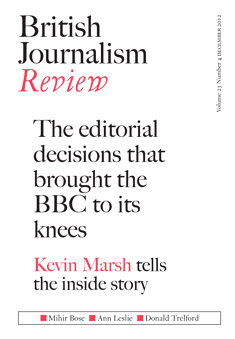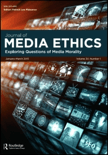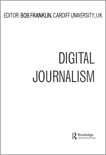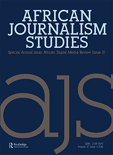
British Journalism Review
Scope & Guideline
Pioneering Discussions on Journalism's Next Chapter
Introduction
Aims and Scopes
- Media Ethics and Accountability:
The journal emphasizes the importance of ethical journalism, scrutinizing issues related to media accountability, the integrity of reporting, and the responsibilities of journalists in the context of truth-telling and public trust. - Political Journalism and Influence:
A significant focus is on the interplay between journalism and politics, examining how media narratives shape public opinion, influence political discourse, and the implications of political power on journalistic freedom. - Impact of Technology on Journalism:
The journal addresses the transformative effects of digital technologies on news production and consumption, exploring topics such as the rise of social media, the challenges of fake news, and the evolving role of journalists in a digital age. - Cultural Reflections in Journalism:
It also reflects on how journalism interacts with cultural narratives, societal issues, and the representation of diverse voices, highlighting the role of media in shaping cultural understanding and public consciousness. - Historical Perspectives on Journalism:
The British Journalism Review often delves into the historical context of journalism, analyzing past events and trends to provide insights into current practices and future directions in the media landscape.
Trending and Emerging
- Journalism and Social Justice:
There is an increasing emphasis on how journalism intersects with social justice issues, highlighting the role of the media in advocating for marginalized communities and addressing systemic inequalities. - Crisis of Trust in Media:
Recent publications are increasingly addressing the crisis of trust in media institutions, exploring public skepticism towards journalism and the implications for democracy and civil society. - Innovative Storytelling Formats:
Emerging trends include discussions on new storytelling formats and multimedia approaches, as journalists adapt to the changing landscape of audience engagement through podcasts, videos, and interactive content. - Post-Truth and Fake News Discourses:
The journal is actively engaging with themes around the post-truth era and the challenge of fake news, analyzing how misinformation affects public perception and the role of journalism in combating it. - Global Perspectives on Journalism:
There is a growing trend towards examining journalism from a global perspective, discussing international issues, and the impact of global events on local journalism practices.
Declining or Waning
- Local Journalism Issues:
Discussions specifically centered on local journalism and its challenges have diminished, possibly reflecting a broader trend of national and global narratives overshadowing local news coverage. - Print Media's Viability:
There seems to be a reduced focus on the viability and future of print journalism, as the discourse increasingly shifts toward digital platforms and multimedia storytelling. - Traditional Reporting Methodologies:
The journal appears to be moving away from discussing traditional reporting practices, with less emphasis on conventional news gathering techniques in favor of innovative approaches and technological advancements. - Celebrity and Entertainment Journalism:
Coverage related to celebrity culture and entertainment journalism has waned, suggesting a shift in focus towards more substantive journalistic themes and societal issues. - Media Industry Economics:
Analysis of the economic aspects of the media industry, including advertising models and revenue generation strategies, has seen a decline, as the emphasis shifts toward content and ethical considerations.
Similar Journals

Palabra Clave
Connecting Scholars, Inspiring DiscoursePalabra Clave is a leading open-access journal published by the UNIV SABANA, FAC COMUNICACION in Colombia, dedicated to advancing the fields of Arts and Humanities as well as Communication. Since its inception in 2001, the journal has committed to providing a platform for innovative research and critical discourse, garnering an impressive Q2 classification in both respective fields. The journal is indexed in Scopus, with a commendable ranking of #26 out of 173 in Arts and Humanities, representing the 85th percentile, and #263 out of 511 in the Communication category, indicating its significant impact within the academic community. With its converged years from 2012 to 2024, Palabra Clave encourages scholars, professionals, and students to engage with contemporary issues through a lens of interdisciplinary scholarship. Accessible through its open-access model, this journal fosters the democratization of knowledge and aims to connect researchers across the globe.

Journal of Media Ethics
Shaping the Future of Ethical Communication.Journal of Media Ethics, published by Routledge Journals, Taylor & Francis Ltd, is a pivotal platform for scholars and practitioners interested in the intersection of media, ethics, and communication. Operating since 2015, this esteemed journal has consistently contributed to the discourse on ethical frameworks in contemporary media practices, making significant strides in the fields of communication and philosophy. With an impressive Q2 category ranking in Communication and a Q1 category ranking in Philosophy as of 2023, the journal demonstrates its influence and relevance, achieving Scopus ranks that place it in the top 87th percentile for Philosophy and the 62nd percentile for Communication. Despite being a subscription-based journal, it caters to an interdisciplinary audience eager to explore the ethical dimensions of media in a rapidly evolving digital landscape. Researchers, professionals, and students alike will find valuable insights and innovative research within its pages, underscoring the importance of ethical considerations in framing media narratives.

Revista de Comunicacion-Peru
Empowering Voices, Shaping Discourse.Revista de Comunicación-Perú is a distinguished open-access journal published by Universidad de Piura, with a dedicated focus on communication studies. Since its inception in 2002, the journal has provided a vital platform for researchers, professionals, and students to disseminate knowledge and foster discourse in the field of communication. As of 2023, it proudly holds a Q1 classification in the Communication category and ranks impressively in Scopus, placing at #117 out of 1304 in Cultural Studies and #160 out of 511 in Communication, demonstrating its significant impact within the academic community. The journal’s scope encompasses diverse topics related to communication, cultural discourse, and media analysis, making it an essential resource for those seeking to explore contemporary issues in these areas. With a commitment to promoting scholarly exchange, Revista de Comunicación-Perú continues to play a pivotal role in shaping the communication landscape in Peru and beyond.

Vestnik Moskovskogo universiteta. Seriya 10. Zhurnalistika
Fostering Critical Perspectives in Journalism EthicsVestnik Moskovskogo universiteta. Seriya 10. Zhurnalistika, published by the prestigious M V Lomonosov Moscow State University, serves as a vital conduit for scholarly discourse in the fields of journalism and communication. With an ISSN of 0320-8079 and an E-ISSN of 0320-8079, the journal showcases rigorously peer-reviewed research and theoretical contributions that span diverse aspects of media studies, social communication, and journalism ethics. As of 2023, it is classified within the Q3 category in both Communication and miscellaneous Social Sciences, ranking #372 out of 511 and #445 out of 604, respectively, indicating its growing influence and relevance in these crucial academic domains. Despite not being Open Access, researchers and students alike can leverage the journal's valuable insights, which continue to shape contemporary understanding of media's impact on society. With a commitment to excellence and a focus on the rapidly evolving landscape of journalism, Vestnik Moskovskogo universiteta. Seriya 10. Zhurnalistika remains an essential resource for anyone looking to engage deeply with current debates and developments in the communication field.

Digital Journalism
Exploring Innovations at the Intersection of Technology and JournalismDigital Journalism is an esteemed academic journal dedicated to advancing the interdisciplinary field of digital communication and journalism. Published by Routledge Journals, Taylor & Francis Ltd, this journal has established itself as a leading resource with a noteworthy Q1 rank in Communication for 2023, placing it among the top tier of journals in this dynamic field. With its ISSN 2167-0811 and E-ISSN 2167-082X, it serves as a pivotal platform for researchers, professionals, and students interested in exploring the intersection of technology and journalism, publishing insightful studies that address contemporary challenges and innovations. The journal has been continually evolving since its inception in 2013 and is set to extend its reach until 2024, consistently attracting high-quality scholarly contributions. With a distinguished rank of 11 out of 511 in Scopus's Social Sciences - Communication category, and boasting an impressive 97th percentile, Digital Journalism is an essential read for anyone keen on understanding the future of news in the digital era.

Revista Mediterranea Comunicacion-Journal of Communication
Cultivating Knowledge in a Global ContextRevista Mediterranea Comunicacion - Journal of Communication, published by UNIV ALICANTE, stands as a significant platform for scholars and practitioners in the fields of Communication and Cultural Studies. With an impact factor that firmly places it in Q2 for Communication and Q1 for Cultural Studies, this open-access journal promotes scholarly dialogue through a rich array of articles, encouraging international discourse that spans various cultural and communicative phenomena. Since its inception in 2010, the Revista Mediterranea Comunicacion has made substantial contributions to understanding contemporary communication dynamics, supported by a growing reputation evidenced by its commendable Scopus rankings—144th in Cultural Studies and 181st in Communication. Researchers, professionals, and students are invited to explore and contribute to this journal, further enhancing the understanding of communication within diverse social contexts.

Theoretical and Practical Issues of Journalism
Fostering Critical Dialogue on Media Ethics and DynamicsTheoretical and Practical Issues of Journalism is a prestigious journal published by Baikal State University, that explores a broad spectrum of topics within the field of journalism. With an ISSN of 2308-6203 and an E-ISSN of 2308-6211, this journal commits to advancing the discourse in both theoretical frameworks and applied methodologies that shape contemporary journalism practices. Although it operates under an open-access model, aiming to enhance accessibility for researchers, professionals, and students worldwide, the journal does not currently display an H-index, reflecting an exciting opportunity for early career researchers to contribute to building its impact. Situated in Irkutsk, Russia, the journal serves as a vital platform for the dissemination of innovative research and critical analysis, aimed at addressing the evolving challenges in journalism today. Its scope encompasses interdisciplinary studies, media ethics, digital journalism, and the socio-political dynamics impacting the news landscape, making it an invaluable resource for anyone vested in the field. As the media environment thrives amidst rapid technological changes, Theoretical and Practical Issues of Journalism remains essential for fostering dialogue and encouraging scholarly efforts that respond to these shifts.

Doxa Comunicacion
Connecting ideas and scholars in the realm of communication.Doxa Comunicación is a prominent open-access journal dedicated to advancing the field of communication studies, published by Universidad San Pablo CEU, under the Faculty of Humanities and Communication Sciences. Established in 2003, this journal has gained recognition for its commitment to disseminating high-quality research and thought-provoking articles, fostering a vibrant academic community. With an ISSN of 1696-019X and an E-ISSN of 2386-3978, Doxa Comunicación occupies a vital niche in the academic landscape of Spain, contributing to both national and international discourses. In the 2023 rankings, it is categorized in the Q3 quartile within the fields of Communication and Social Sciences (miscellaneous), reflecting its competitive standing among peer publications. The journal's diverse scope, including contemporary communication theories and practices, ensures relevance for researchers, professionals, and students alike. With a Scopus rank of #333 in Social Sciences (miscellaneous) and #291 in Communication, Doxa Comunicación serves as an essential platform for innovative research that addresses the complex challenges of modern communication in a rapidly evolving society.

Revista Comunicacao Midiatica
Advancing Research in Communication StudiesRevista Comunicação Midiática is a prominent academic journal focusing on the fields of communication, media studies, and cultural dynamics, published by Universidade Estadual Paulista Júlio Mesquita Filho, Facility of Architecture, Arts & Communication. With its ISSN 2236-8000, this journal aims to disseminate innovative research, theoretical advancements, and practical insights that contribute to a deeper understanding of communication processes in contemporary society. Although it currently does not provide Open Access options, the journal serves as a valuable resource for researchers, professionals, and students who are keen to explore the intricate relationships between media and culture. Located in Bauru, Brazil, the journal is committed to fostering multidisciplinary dialogue and enhancing scholarly discourse, making it an invaluable addition to the academic landscape in the realm of media studies.

African Journalism Studies
Elevating the study of journalism within the African context.African Journalism Studies is a leading journal dedicated to advancing the field of journalism research within the African context. Published by Routledge Journals, a prestigious division of Taylor & Francis Ltd, this journal features a rich repository of scholarly articles that explore critical issues in journalism, media practices, and communication strategies across the continent. With an impressive Q2 ranking in Communication for 2023, African Journalism Studies is recognized for its influence and quality, ranking #202 out of 511 journals in social sciences communication and maintaining a 60th percentile position. Despite being a non-open access publication, it remains essential for researchers, professionals, and students looking to deepen their understanding of the dynamics of journalism in Africa, offering insights into converged media practices from 2015 to 2024. The journal contributes significantly to the academic discourse, fostering a more profound knowledge base and encouraging informed discussions that reflect the evolving landscapes of African journalism.